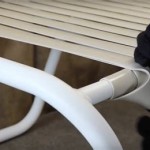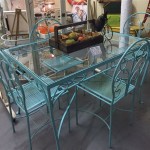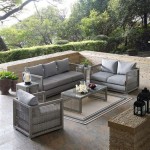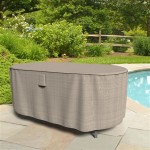Designing The Perfect Patio Furniture Layout: Planning for Optimal Outdoor Living
Creating an inviting and functional patio space requires careful consideration of furniture layout. A well-designed patio extends living space outdoors, providing an area for relaxation, dining, and entertainment. Effective planning maximizes available space, ensures comfortable traffic flow, and enhances the overall aesthetics of the outdoor environment. This article will explore key considerations when designing the perfect patio furniture layout, focusing on factors that contribute to a harmonious and functional outdoor living area.
Assessing the Patio Space and Defining its Primary Purpose
The initial step in designing a patio furniture layout involves a thorough assessment of the available space. This includes measuring the dimensions of the patio, noting any existing architectural features such as doors, windows, and steps, and considering the patio's orientation in relation to sunlight and prevailing winds. Understanding these elements is crucial for determining the most suitable furniture arrangement.
Furthermore, defining the primary purpose of the patio is essential. Will it primarily be used for dining, lounging, entertaining, or a combination of these activities? This will dictate the type and quantity of furniture needed. A dining-focused patio will require a table and chairs, while a lounging area might prioritize sofas, armchairs, and coffee tables. An entertainment-focused patio might benefit from modular seating arrangements that can be easily reconfigured for different group sizes.
Consider the size of the anticipated gatherings. A patio intended for frequent large gatherings will require more seating than one intended for smaller, more intimate settings. Also, think about storage needs. Will cushions need to be stored when not in use? Where will outdoor games or gardening tools be kept? Integrating storage solutions into the patio design can help maintain a clutter-free and organized space.
Analyzing the existing landscaping is also important. Trees, shrubs, and flowerbeds can influence furniture placement and create natural boundaries within the patio space. Consider the views from the patio and how the furniture arrangement can enhance or detract from them. If privacy is a concern, screening options such as hedges, fences, or trellises can be incorporated into the design.
Selecting Furniture Styles and Materials for Durability and Aesthetics
Choosing the right furniture styles and materials is critical for both the aesthetics and longevity of the patio. Furniture should complement the architectural style of the house and the overall design of the outdoor space. Consider the color palette, textures, and shapes of the furniture in relation to the surrounding environment.
Material selection is largely dictated by the climate and the level of maintenance desired. Teak, cedar, and redwood are popular choices for wooden patio furniture due to their natural resistance to rot and insects. However, they require periodic sealing or staining to maintain their appearance. Metal furniture, such as aluminum or wrought iron, is durable and weather-resistant but can become hot in direct sunlight. Resin wicker and synthetic rattan are lightweight, easy to clean, and resistant to fading and cracking, making them suitable for a variety of climates.
Upholstery fabrics should be specifically designed for outdoor use, featuring water-repellent and UV-resistant properties. Sunbrella, Outdura, and other similar fabrics are engineered to withstand the elements and maintain their color and texture over time. Consider the color and pattern of the upholstery in relation to the surrounding environment and the overall design scheme.
Scale is another important factor to consider when selecting furniture. Larger patios can accommodate larger pieces of furniture, while smaller patios require more compact and space-saving designs. Avoid overcrowding the patio with too much furniture, as this can make the space feel cramped and uncomfortable. Choose furniture that is proportional to the size of the patio and the surrounding landscape.
Implementing Practical Layout Strategies for Comfort and Functionality
Once the furniture has been selected, the next step is to implement a practical layout strategy that maximizes comfort and functionality. This involves considering traffic flow, creating designated zones for different activities, and incorporating elements that enhance the overall ambiance of the patio.
Traffic flow is a critical consideration in patio design. Ensure that there is ample space for people to move freely around the furniture without bumping into it. Maintain clear pathways between seating areas, dining areas, and access points to the house or garden. Avoid placing furniture in areas that obstruct natural pathways or create bottlenecks. Create a mock layout using tape on the patio floor to visualize the furniture placement and test the traffic flow before making any permanent arrangements.
Creating designated zones for different activities can help to organize the patio space and make it more functional. For example, a dining zone might include a table and chairs, while a lounging zone might feature a sofa, armchairs, and a coffee table. Separate zones can be visually defined using outdoor rugs, potted plants, or changes in elevation. Consider the proximity of each zone to other areas of the patio and the house. For example, the dining area might be located near the kitchen for easy access to food and drinks.
Incorporating outdoor lighting is essential for extending the usability of the patio into the evening hours. String lights, lanterns, and path lighting can create a warm and inviting atmosphere. Consider the placement of lighting fixtures in relation to the furniture layout to ensure adequate illumination for dining, reading, and socializing. Use dimmers to adjust the lighting levels to suit different moods and activities.
Adding accessories such as throw pillows, blankets, and decorative objects can enhance the comfort and style of the patio. Choose accessories that complement the furniture and the overall design scheme. Consider the durability and weather resistance of outdoor accessories, as they will be exposed to the elements. Regularly clean and maintain outdoor accessories to keep them looking their best.
Furthermore, it is important to consider shade. Depending on the patio's orientation and the climate, providing shade can be crucial for making the space more comfortable during the hottest hours of the day. Shade can be provided by trees, umbrellas, pergolas, or awnings. Consider the placement of shade structures in relation to the furniture layout to ensure that the seating areas are adequately protected from the sun.
Wind is another factor to address. If the patio is exposed to strong winds, consider using windbreaks such as screens, hedges, or fences to create a more sheltered environment. Furniture can also be anchored to prevent it from being blown around in strong winds. Choose furniture made from heavier materials or use weighted cushions to stabilize them.
Finally, consider accessibility. Ensure that the patio is accessible to people of all abilities. This may involve providing ramps or gentle slopes instead of steps, using furniture with appropriate seat heights, and ensuring that pathways are wide enough for wheelchairs or walkers.
By carefully considering the available space, selecting appropriate furniture styles and materials, and implementing practical layout strategies, it is possible to design the perfect patio furniture layout that enhances the functionality and enjoyment of the outdoor living space. A well-designed patio is an extension of the home, providing a comfortable and inviting area for relaxation, dining, and entertainment.

How To Design The Perfect Outdoor Space

How To Design The Perfect Patio Dk Studio

Designing The Perfect Patio In 7 Steps

How To Design A Spacious Outdoor Living Area With The Right Furniture

Designing The Perfect Outdoor Oasis Patio Furniture Space Planning Ma

Backyard Patio Ideas Small Covered Concrete Brick And Wood

7 Design Mistakes You Don T Want To Make With Your Patio Furniture All American Pool And Blogall Blog

How To Host The Perfect Outdoor Party With Comfortable Patio Seating

From Patios To Pools The Best Outdoor Living Space Ideas

Design The Perfect Outdoor Living Room Cottage Journal
See Also








